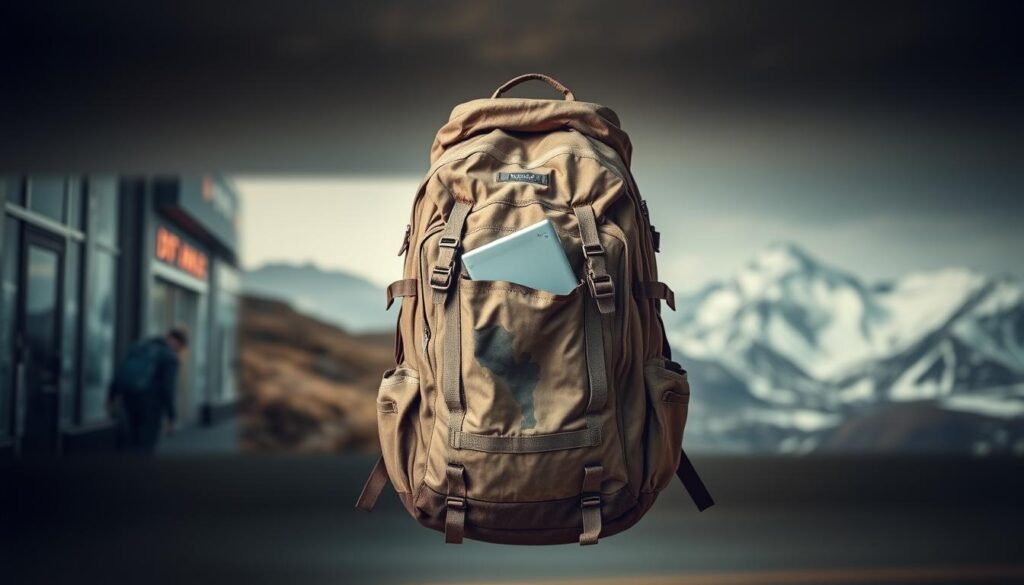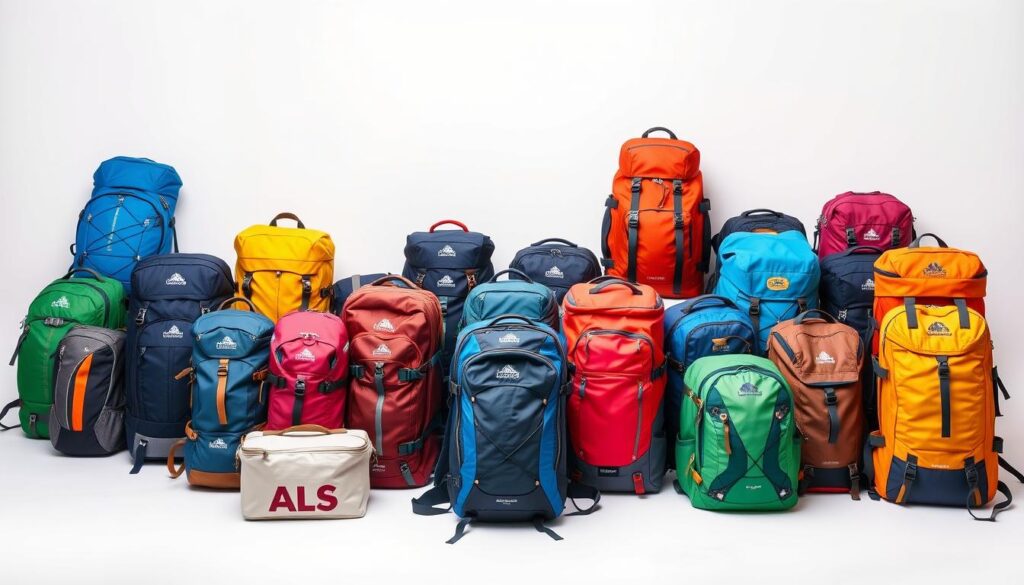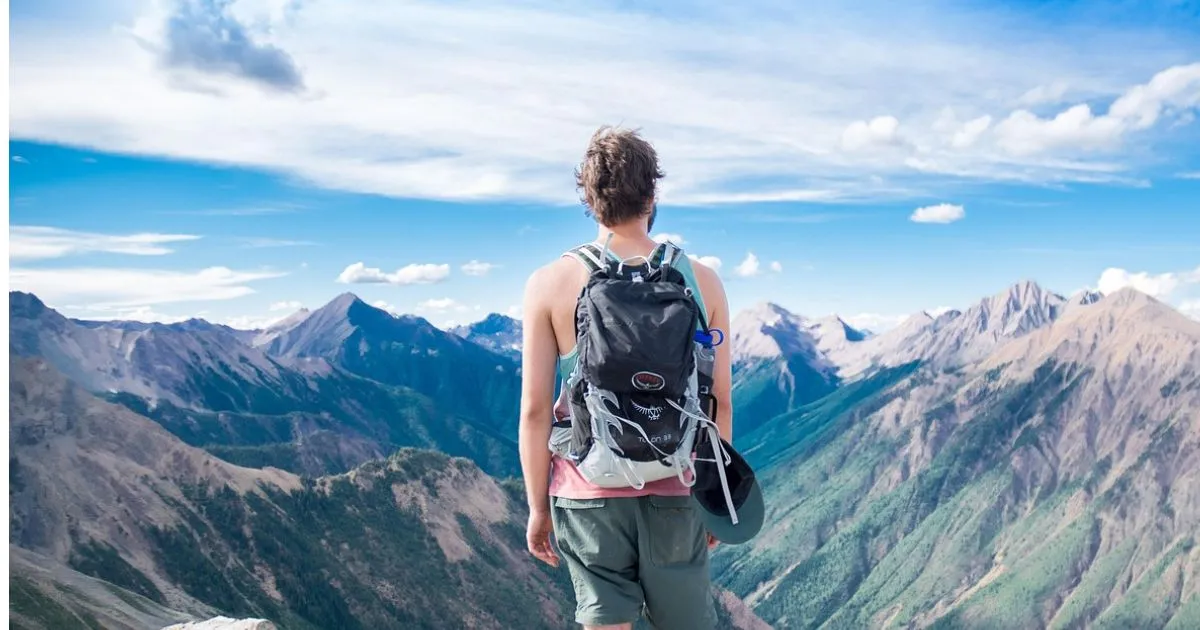Travel Backpack Buying Guide 2025: How to Choose the Perfect Pack
Traveling through crowded airports can be stressful. But, having the right travel backpack makes it easier. My initial journey to Southeast Asia was a transformative experience.
My backpack was my go-to for everything, keeping me moving and carefree.
Travel backpacks are more than luggage. They’re your home away from home, your storage, and your best friend. Whether you travel for the weekend or around the world, the right backpack is key. It offers freedom and flexibility that regular luggage can’t.
Selecting a backpack involves more than just considering its size or appearance; it’s about understanding what you require for your travels.
The perfect backpack fits your adventure, from hiking to business trips. It keeps you comfortable, safe, and ready for anything.
Table of Contents
Understanding Travel Backpack Types
Selecting the perfect backpack for your journey is crucial. Knowing the different types of knapsacks and rucksacks can greatly improve your experience. Each backpack is made for specific travel needs.
What you need in a backpack depends on your travel plans. Different styles have their own benefits for different trips.
Carry-on Backpacks
Carry-on backpacks are made to fit in overhead compartments. They have:
- Compact design fitting overhead compartments
- Lightweight materials
- Multiple organizational compartments
- Quick-access pockets for travel documents
Hiking and Trekking Packs
Hiking knapsacks are for those who love the outdoors. They’re built tough for wilderness adventures.
- Enhanced durability
- Ergonomic support systems
- Large water-resistant compartments
- Specialized attachment points for gear
Business Travel Backpacks
Business travelers need backpacks that are both functional and stylish. Modern business backpacks have:
- Padded laptop compartments
- Sleek, professional appearance
- RFID-protected pockets
- Comfortable ergonomic designs
Pro tip: Think about your main travel purpose when picking a backpack. It guarantees you’ll experience maximum comfort and practicality.
Essential Features for My Back Pack
Choosing the right daypacks or haversacks for travel is key. Your backpack should be a trusted friend that meets many needs.
Comfort is the top thing to think about in a travel backpack. Look for these important features:
- Padded shoulder straps that spread out the weight
- Back panels with ventilation to ensure you stay cool
- Customizable sternum straps for added stability
Durability is also very important for haversacks. Your backpack should handle different places well and keep your stuff safe.
Key durability features include:
- Water-resistant materials
- Reinforced stitching at stress points
- High-quality zipper construction
Organizational features make a big difference. Look for backpacks with smart designs that let you find things easily and keep them safe.
Pro tip: Choose backpacks with many internal and external pockets to pack better.
Security features are also crucial. Look for backpacks with:
- Hidden passport pockets
- Lockable zippers
- RFID-blocking compartments
By focusing on these key features, you’ll get a backpack that makes your travels better. It will perform well in many places.
Size and Capacity Considerations
Choosing the right size for your travel bags is key for a smooth trip. Backpacks come in many sizes and capacities, each for different travel needs. Knowing these sizes helps you pick the best backpack for your adventures.
- Travel duration
- Destination type
- Personal packing style
- Transportation methods
Carry-on Size Limits
Airlines have specific rules for carry-on bags. Most US carriers have similar rules, but always check the airline’s policy before your trip.
Typical carry-on backpack sizes are:
- 22 x 14 x 9 inches for domestic flights
- 21 x 13 x 8 inches for international travel
Volume Measurements
Backpack capacity is measured in liters. This simplifies comparing storage capacities. Common sizes are:
- Daypacks: 10-30 liters
- Weekend bags: 30-50 liters
- Extended travel backpacks: 50-70 liters
True Volume vs Stated Capacity
The stated capacity might not always match the actual usable space. Design, padding, and structure can affect space. Always read reviews and try on backpacks to see their real capacity.
Selecting the appropriate backpack size is essential for ensuring comfort and adhering to travel regulations. Make sure to assess your needs carefully and choose a backpack that aligns with your travel preferences.
Materials and Durability
Choosing the right material for your backpack is key for durability and performance. Different materials have unique benefits for travelers and outdoor lovers in various settings.
Rucksacks usually come in three main material types:
- Nylon: Lightweight and water-resistant
- Polyester: Affordable and color-fast
- Canvas: Extremely durable and classic
Fabric strength is measured by the denier rating. This shows the material’s thickness and durability. Higher denier numbers mean stronger knapsacks that handle rough use and tough conditions well.
“Your backpack’s material determines its lifetime performance and reliability.”
When picking your travel buddy, think about these material traits:
- Weight resistance
- Water repellency
- Tear strength
- UV protection
Experts say invest in top-notch materials that fit your travel style. Whether you’re in the city or the wild, the right material keeps your rucksack reliable.
Comfort and Ergonomics
Choosing daypacks or haversacks means picking comfort. Your backpack should become an extension of yourself.
It should spread out the weight and ease the strain on your body.
The right backpack design can make your travel better. It stops muscle fatigue and keeps you safe from long-term harm.
Shoulder Straps: Your Comfort Foundation
Good shoulder straps are key for comfort. Look for these important features:
- Thick, padded materials
- Adjustable length and width
- Curved design that follows natural shoulder contours
- Breathable fabric to reduce sweating
Hip Belts: Redirecting Weight Effectively
A good hip belt is vital for heavy haversacks.It transfers up to 80% of the load from your shoulders to your hips.
This cuts down on shoulder strain a lot.
Advanced Back Panel Systems
Modern backpacks have cool back panel tech for better airflow and comfort:
- Mesh ventilation channels
- Contoured foam padding
- Suspension systems that create air gaps
Buying a backpack with smart design is investing in your comfort and health.
Weather Resistance and Protection

It’s vital to keep your gear dry while traveling. Weather resistance can save your belongings from damage. Selecting the right travel bag is crucial.
Backpacks come in different levels of weather protection. You can find ones that are water-resistant or fully waterproof. Clarifying your needs will help you pick the perfect backpack for your trips.
- Water-resistant backpacks: Protect against light rain and moisture
- Water-repellent materials: Provide enhanced protection with special coatings
- Waterproof backpacks: Offer complete protection in extreme conditions
When looking at weather resistance in travel backpacks, consider these factors:
| Protection Level | Suitable Environments | Recommended Use |
|---|---|---|
| Water-resistant | Urban travel, light rain | Daily commutes, short trips |
| Water-repellent | Moderate rainfall | Weekend hiking, light outdoor activities |
| Waterproof | Extreme weather conditions | Intense outdoor expeditions, marine environments |
To keep your backpack weather-resistant, clean it often and reapply treatments. Durable Water Repellent (DWR) sprays can help restore your bag’s protective capabilities.
Pro tip: Choose backpacks with rain covers for extra protection. These covers add a layer of moisture defense in changing weather.
Organization and Accessibility
Choosing the right knapsacks and rucksacks is more than just size and comfort. The organizational features are key. A well-designed backpack can turn from a simple storage solution to a traveler’s best friend.
Clamshell vs Top Loading: Choosing Your Access Style
The style of your backpack’s opening plays a major role in how you pack and access your items. Clamshell designs offer:
- Complete visibility of contents
- Easy full-pack organization
- Quick access to items at the bottom
Top-loading rucksacks provide:
- Better weather resistance
- Compact external profile
- Ideal for hiking and outdoor adventures
Strategic Compartment Layouts
Modern knapsacks have smart compartment designs for different travel needs:
| Compartment Type | Best For |
|---|---|
| Laptop Sleeve | Business travelers, digital nomads |
| Hidden Pockets | Storing valuables securely |
| Compression Straps | Stabilizing load, reducing bulk |
Security Features That Protect
Protecting your belongings is vital when on the road. Look for these security features in your next backpack:
- Lockable zippers
- RFID-blocking pockets
- Cut-resistant materials
- Hidden passport compartments
Pro tip: Always prioritize a backpack that balances accessibility with security for seamless travel experiences.
Popular Brands and Price Points

Looking for the perfect travel companion? Knowing about daypacks and haversacks is key. There is a vast array of choices available in the market, catering to various budgets and travel preferences.
Top brands in travel backpacks offer various solutions:
- Osprey: Known for exceptional durability and comfort
- Peak Design: Specializes in modern, sleek haversacks with innovative features
- Tortuga: Focuses on urban travel and carry-on friendly designs
- Cotopaxi: Offers colorful, ethically produced daypacks
Prices fall into three main categories:
- Budget-Friendly ($50-$100): Solid entry-level daypacks with basic functionality
- Mid-Range ($100-$250): Enhanced features, better materials, improved comfort
- Premium ($250-$500): Advanced materials, sophisticated design, maximum durability
Your perfect backpack depends on your travel needs, budget, and preferences. Think about weight, comfort, and use when choosing.
Pro Tip: Invest in a quality haversack that matches your travel style and provides long-term value.
How to Pack Your Backpack Efficiently
Packing your bags needs a plan and smart organization. Whether you’re heading out for a weekend trip or a long journey, perfecting your packing skills can greatly enhance your experience.
Begin by choosing the right packing tools. Packing cubes are a big help, making your space more and keeping things in order. They stop clothes from getting jumbled and make unpacking easy.
- Rolling clothes instead of folding them helps prevent wrinkles
- Compression bags are perfect for optimizing space, particularly for larger items like jackets
- Opt for versatile clothing that can easily be paired together
Balancing the weight in your backpack is essential. Put heavy things near your back for better balance and less strain. Fill the empty spaces with lighter items.
Here are some smart packing tips:
- Put shoes at the bottom of your backpack
- Make the most of your shoe space by storing smaller items like socks or chargers within them
- Utilize every inch of available space effectively
“Smart packing isn’t about bringing everything—it’s about bringing the right things.”
The aim with travel bags is to have a light, organized system. This supports your adventure and keeps you comfortable.
Conclusion
Selecting the appropriate travel knapsack is key. Consider what you’ll need for your adventures. Your backpack should be comfortable, useful, and last a long time.
Every traveler is different. So, finding the perfect backpack is all about what you need. It’s important to select one that fits your personal travel style.
Looking for the best backpack means checking a few things. Size, material, and how it feels are all important. The right backpack makes your travels better, no matter where you go.
Reflect on the essentials you require in a backpack. Investing time in research pays off, as a good backpack is more than just a simple bag. It’s a partner that helps you explore and keeps your things safe.
Your dream backpack is out there. Use what you learned here to find it. Choose wisely, and it will make all your travels better.
FAQ
How does a travel backpack differ from a regular one?
How can I select the right size for a travel backpack?
Are expensive travel backpacks worth the investment?
How important are back panel and shoulder strap designs?
Which materials are ideal for travel backpacks?
Is it possible to use a travel backpack as a carry-on?
How do I maintain my travel backpack?
Which security features are important in a travel backpack?
Are hiking backpacks suitable for general travel?
What’s the most efficient way to pack a travel backpack?
Share Your Opinion & Experience
💬 Have you tried this idea or do you have better tips? Share them with us so other travelers can benefit.
There are no reviews yet. Be the first one to write one.

